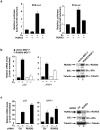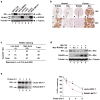RUNX3 acts as a tumor suppressor in breast cancer by targeting estrogen receptor α
- PMID: 21706051
- PMCID: PMC3697905
- DOI: 10.1038/onc.2011.252
RUNX3 acts as a tumor suppressor in breast cancer by targeting estrogen receptor α
Abstract
Transcription factor RUNX3 is inactivated in a number of malignancies, including breast cancer, and is suggested to function as a tumor suppressor. How RUNX3 functions as a tumor suppressor in breast cancer remains undefined. Here, we show that about 20% of female Runx3(+/-) mice spontaneously developed ductal carcinoma at an average age of 14.5 months. Additionally, RUNX3 inhibits the estrogen-dependent proliferation and transformation potential of ERα-positive MCF-7 breast cancer cells in liquid culture and in soft agar and suppresses the tumorigenicity of MCF-7 cells in severe combined immunodeficiency mice. Furthermore, RUNX3 inhibits ERα-dependent transactivation by reducing the stability of ERα. Consistent with its ability to regulate the levels of ERα, expression of RUNX3 inversely correlates with the expression of ERα in breast cancer cell lines, human breast cancer tissues and Runx3(+/-) mouse mammary tumors. By destabilizing ERα, RUNX3 acts as a novel tumor suppressor in breast cancer.
Conflict of interest statement
Figures




Similar articles
-
Tumor suppressor function of RUNX3 in breast cancer.J Cell Biochem. 2012 May;113(5):1470-7. doi: 10.1002/jcb.24074. J Cell Biochem. 2012. PMID: 22275124 Free PMC article.
-
Prolyl isomerase Pin1 downregulates tumor suppressor RUNX3 in breast cancer.Oncogene. 2013 Mar 21;32(12):1488-96. doi: 10.1038/onc.2012.178. Epub 2012 May 14. Oncogene. 2013. PMID: 22580604 Free PMC article.
-
RUNX3 Meets the Ubiquitin-Proteasome System in Cancer.Cells. 2023 Feb 24;12(5):717. doi: 10.3390/cells12050717. Cells. 2023. PMID: 36899853 Free PMC article. Review.
-
RASSF1A inhibits estrogen receptor alpha expression and estrogen-independent signalling: implications for breast cancer development.Oncogene. 2012 Nov 22;31(47):4912-22. doi: 10.1038/onc.2011.658. Epub 2012 Jan 23. Oncogene. 2012. PMID: 22266866
-
STAT1-deficient mice spontaneously develop estrogen receptor α-positive luminal mammary carcinomas.Breast Cancer Res. 2012 Jan 20;14(1):R16. doi: 10.1186/bcr3100. Breast Cancer Res. 2012. PMID: 22264274 Free PMC article.
Cited by
-
Brd4 maintains constitutively active NF-κB in cancer cells by binding to acetylated RelA.Oncogene. 2014 May 1;33(18):2395-404. doi: 10.1038/onc.2013.179. Epub 2013 May 20. Oncogene. 2014. PMID: 23686307 Free PMC article.
-
Clinicopathological significance and potential drug target of RUNX3 in breast cancer.Drug Des Devel Ther. 2014 Dec 5;8:2423-30. doi: 10.2147/DDDT.S71815. eCollection 2014. Drug Des Devel Ther. 2014. PMID: 25525332 Free PMC article.
-
The RUNX family: developmental regulators in cancer.Nat Rev Cancer. 2015 Feb;15(2):81-95. doi: 10.1038/nrc3877. Epub 2015 Jan 16. Nat Rev Cancer. 2015. PMID: 25592647 Review.
-
RUNX3 in Stem Cell and Cancer Biology.Cells. 2023 Jan 25;12(3):408. doi: 10.3390/cells12030408. Cells. 2023. PMID: 36766749 Free PMC article. Review.
-
Expression and Prognosis Analyses of Runt-Related Transcription Factor Family in Human Leukemia.Mol Ther Oncolytics. 2018 Dec 18;12:103-111. doi: 10.1016/j.omto.2018.12.008. eCollection 2019 Mar 29. Mol Ther Oncolytics. 2018. PMID: 30719500 Free PMC article.
References
-
- Cheskis BJ, Greger JG, Nagpal S, Freedman LP. Signaling by estrogens. J Cell Physiol. 2007;213:610–7. - PubMed
-
- Duong V, Boulle N, Daujat S, Chauvet J, Bonnet S, Neel H, et al. Differential regulation of estrogen receptor alpha turnover and transactivation by Mdm2 and stress-inducing agents. Cancer Res. 2007;67:5513–21. - PubMed
-
- Ekena K, Weis KE, Katzenellenbogen JA, Katzenellenbogen BS. Identification of amino acids in the hormone binding domain of the human estrogen receptor important in estrogen binding. J Biol Chem. 1996;271:20053–9. - PubMed
Publication types
MeSH terms
Substances
Grants and funding
LinkOut - more resources
Full Text Sources
Molecular Biology Databases
Miscellaneous

